|
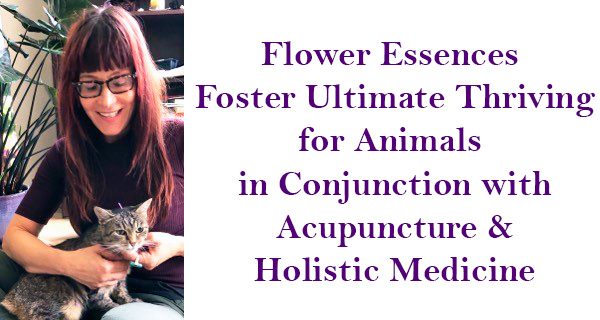
Editor’s note: Practitioner Shanti Zinzi of San Francisco, CA, educated in Somatic Psychology and Traditional Chinese Medicine, works primarily with animal patients. FES asked Shanti to elaborate on her work with flower essences in her practice.
Insights regarding the use of acupuncture and flower essence therapy in tandem with each other
Observations in regard to flower essences and other
modalities used with your animal patients
The pericardium point and the use of the green flower essence
remedies
Other specific acupuncture points that correspond with particular flower essences
Exemplary animal case studies, both behavioral and cases involving acupuncture and flower essences
Diet, immune system and a more robust constitution
Shifting diet, vitality and relationship
Integration of feral cat into household
Healing and behavioral modification
Healing aggression
Healing sensitive startle response
Other observations regarding the work with flower essences and about particular flower essences
About
Insights regarding the use of acupuncture and flower essence therapy in tandem with each other
In my experience, the flower essences foster an ultimate thriving in conjunction with acupuncture/holistic medicine. I find these modalities work on subtle matrix systems and have a truly synergistic relationship.
Canines are generally easier, but I often felt limited with Chinese herbs and many feline cases due to palatability issues. Forcing bitter herbs or supplements isn't an option I encourage because it is “often” not received in a humane way. Some animals are easy, and some humans are quite graceful and deft at administration, but forcing pills or bitter tasting tinctures down an animal’s throat is often suffered as a violation.
Many felines refuse to eat if herbs or supplements are mixed with their food, which can then cascade into a whole other set of grave medical problems.
I rely on flower essences for many things: emotional support; instilling joy; creating new behavioral and neuronal pathways; assisting with dietary modifications; increasing energy; helping an overly anxious creature reorganize and open a space to absorb new learning for behavioral modifications.
The flower essences create the space or reweave the pattern to nurture and bring fulfillment.
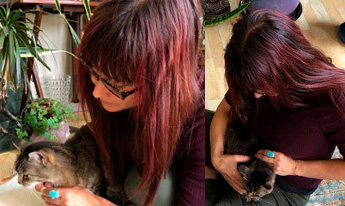
Observations in regard to flower essences and other modalities used with animal patients
With all of my cases, I believe it is paramount to address the whole picture, including age and breed propensities, diet, environment, early life experiences, traumas, all relationships (to caretaker and other quadrupeds in their home), sleeping patterns, mental stimulation, exercise, and former history, both medical and incidental. I also visit the home or view video, so I can get an understanding of the dynamics there.
With particularly fearful dogs, I prioritize establishing trust as they are often overly armored, and unable to relax into a treatment. I will often schedule body work, somatic therapy or more gross manipulation modalities to ensure they associate a learned response of trusting my touch.
|
The flower essences truly inspire a receptive container to actually receive the treatment.
|
For medical cases with inappetence, I often add California Pitcher Plant to enliven digestive fires.
For animals refusing an optimal, appropriate diet (i.e., kibble junkies that refuse to eat optimal nutrition), I may add a drop of Cayenne to their formula to help initiate new behaviors, in conjunction with environmental suggestions.
For behavioral work, I advise environmental changes, body language lessons for the guardian, and I insist on addressing the other animals in the household, as well.
With behavioral cases, I investigate their history. For example, a feline separated from the queen and litter too early that never learned bite inhibition, I will create a remedy that addresses the trauma; for example, Mariposa Lily is very nurturing in a maternal way, Madrone may help with lack of proper weening, and I will add Snapdragon since they are having issues controlling their biting reflex. Sadly, this is actually being cultivated in shelter environments. Cassiope, Madrone and Angelica are used for animals weened too early.
I sometimes see the felines’ experiences are not understood. Some are overstimulated by qualities of touch their caretakers are unconsciously communicating. For these cases, I may add Pussy Paws or Calendula to reweave their response to touch. I utilize awareness exercises so their human becomes attuned to what they may be translating through characteristics of their touch.
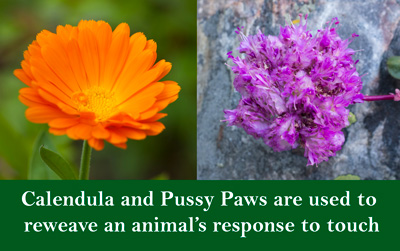
I also often see concurrent diseases in humans and their critters. This can include asthma, IBD, lymphoma, anxiety or neurosis. I give them all flowers. The humans are often so pleased with the progress of their critters, I am asked to craft a formula for the client anyway.
|
I honestly feel the flower essences are knitting or reweaving a sort of psycho-spiritual deficit or wound in the patient to enhance their life and bring a more embodied and fully embraced existence.
|
The pericardium point and the use of the green flower essence remedies
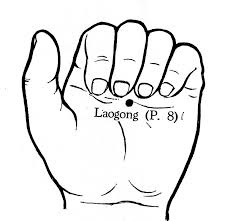 Pericardium 8 is a profoundly powerful energetic point in Classical texts. Among many indications, this is the point of your heart’s desire, in one text referred to as the “Palace of God.” Pericardium 8 is a profoundly powerful energetic point in Classical texts. Among many indications, this is the point of your heart’s desire, in one text referred to as the “Palace of God.”
As a healer, I find that it is imperative to embody and align one’s hands with one’s heart, mind and with the cosmic forces and the vital breathing pulse of the earth.
The desire to liberate others from suffering is in some way part of every healer’s journey. This can be accessed from this point, one’s true purpose.
Sometimes to illicit a response in my patient I may also take the same remedy recommended or at least place drops onto my palm, PC8 (being in the center). It is a profound energy center point of both flow and receptivity. This ensures that my hands, touch and mental focus deliver and direct the channels, pathways and manipulation of the needles with the medicine of the flowers.
The sacred Lady’s Mantle, a revered alchemical wonder, delivers an oxygenated refreshing green, abundant earth-centered emission. It is an essential prana, qi or life force resonance that modern society has been denied by over development.
Animals don’t need psycho-pharmaceuticals for what is perceived as “behavioral issues,” they need to renew their energetic, corporeal and subtle body to the earth’s body and the abundant green to rewire and align with the cornucopia. We are all part of the cosmos and energetic forces; the essences help to bring this awareness into conscious alignment.
This is a vital and imperative relationship that became skewed with the advent of the industrial revolution, congested city life, and our current Cartesian paradigm of medicine. It is in the green flower essences, Green Nicotiana, Green Rose, Green Rein Orchid and Lady’s Mantle that this abundant renewing relationship to our sacred planet is restored.
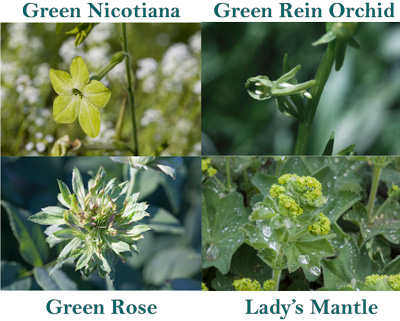
Green Nicotiana I also use for asthma patients.
Sometimes it is not always possible with city dweller critters to have them in nature other than with potted plants in a condominium, but we can deliver this embodied refreshing consciousness to them with Lady’s Mantle. It also involves the guardian’s mental state and lifestyle, but the properties of the healing pure dew that dances across the leaves of Achemilla is sure to nourish a weary, frazzled soul.
Other specific points that correspond with particular flower essences
My approach is really to treat individually. I try to meet them where they are and allow it to unfold in layers.
I am a fan of oral and mucosal administration, misting the area or auric field or lightly brushing already misted hands lightly around the auric body. I do like transdermal application for permeability reasons, which may be the furless part of the pinna or ear flap. The ear topography also has many corresponding points. Due to thin cartilage and accessible blood vessels, this area may help with absorption into the blood stream (sans thickened, or hematoma ridden ear cartilage).
I like to do an acupressure massage with the essences from yin tang through GV 20 and 19 to GV 14. This is very soothing for animals as well. I trace the base of the ears which corresponds to the triple warmer meridian. This channel is responsible for fluid transformation and a relationship to the lymphatic system. Although not mentioned in classical texts, the late Giovanni Maciocia attributed this meridian to stimulating the coming and going of the ethereal soul.

|
| |
With a misted hand of Mariposa Lily , Pink Yarrow or maybe Mallow over the dorsal area, surrounding the heart and UB 15, the heart’s shu point, I will cup my opposite hand over the conception vessel to cover or contain.
One of my favorite calming nurturing points is Ren or CV 17, Sea of Tranquility. In humans, it is located on the midline of the sternum or breastbone, in the depression level with the junction of the 4th rib space and the sternum. In critters, it is found on the ventral midline at the 4th intercostal space.
This vessel is a nurturing vessel, calms the mind, and helps find balance, security and safety. Animals love this point. They love having their sternum gently caressed, just as humans find a hand over their heart comforting.
This is the mu point of the pericardium and has a host of emotional benefits. Currently, Traditional Chinese Medicine (TCM) places an emphasis on biomedical and empirical indications to prove its efficacy to the West, but the pearls are in the classical pre-Maoist applications that addressed subtler issues.
When the animal is behaving reticently to the caretaker for reasons such as a traumatic veterinary visit, a terrifying experience at the groomers or the owner permitting the critter to be overstimulated by a guest or bullied by another resident animal, I will often use this point. The conception vessel or Ren channel is a bonding vessel and fosters the animal’s ability to freely bond to their caretaker.
If I sense the animal is bound or blocked in their heart chakra, concealing grief, or has asthma, I will use flowers such as Mariposa Lily and Green Nicotiana. This is a wonderful point for nurturance and to help quell anxiety. Most feel pretty invigorated after needle manipulation because it unbinds the chest.
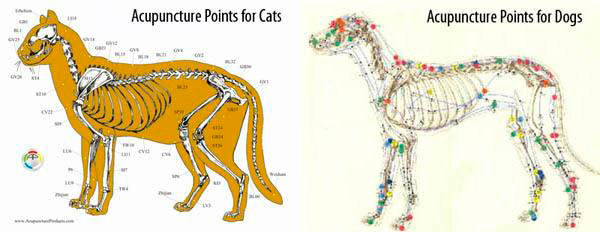
|
| |
Exemplary animal case studies, both behavioral and cases involving acupuncture and flower essences
Diet, immune system and a more robust constitution
Flower essences have helped with changing the diet of an incredibly finicky 11 y/o dwarf Persian cat who suffered a chronic skin and fungal condition for 3+ years. She refused to ingest anything other than a very poor quality glyphosate corn and soy based kibble that was not helping her immune system.
Coupled with environmental and behavioral modification, I used the essences to open a pathway to transition to a better quality diet to start addressing her immune system. Lily was somewhat isolated due to her owner’s fear of spreading ringworm and coupled with a new zealous puppy in the house.
Lily’s remedy was Garlic, Self-Heal, Shooting Star, Echinacea, Indian Paintbrush and Cayenne.
Several days into this formula, she started to resurface from self-imposed retreat to seek her mum. She seemed to develop more confidence and not be as overwhelmed with the other three animals.
Two months later, along with homeopathy, her clipped coat had grown in with no lesions, she is now able to groom and make contact with her fur whereas prior, she would phantom lick or lick the air while motioning her front forelimb.
For animals with a very stagnant constitution, I ensure there are no medical issues for example, hypothyroidism, etc., and may implement an original formula to help move that energy before I can address any underlying deficiencies with acupuncture and Chinese medicine. For their first formula, I may add a touch of Cayenne for a cooler constitution, or Blackberry to a warmer constitution.
Shifting diet, vitality and relationship
Cyrano, a 17 y/o old feline with advanced renal disease and hyperthyroidism needed a diet change and help with his finicky appetite/nausea.
Besides receiving his western medications and subcutaneous hydration, I gave California Pitcher Plant for appetite, Echinacea, Olive, Self-Heal, California Wild Rose and Garlic .
His appetite returned and we were able to alter his limited palate to a lower sodium, lower phosphorous food with a better quality moderate protein content. His kidney values decreased as evidenced on his next lab test.
His former cuddle buddy, Yvette, started to ignore Cyrano as his health deteriorated. For weeks, she would attack him following his veterinary visits. She received “love potion #9.” The owner perceived the two were soul mates and felt restoring their bond would be paramount in Cyrano’s well-being.
Therefore for Yvette, essences of Pink Yarrow for empathy, Holly for the group dynamic, Sweet Pea and Star Tulip for receptivity, Baby Blue Eyes to open her to her male counterpart, and a touch of Mariposa Lily to incite her maternal instincts were formulated together. Apparently within two days, Cyrano was found sleeping on Yvette’s legs which hadn’t been witnessed in months.
Integration of feral cat into household
For a very aggressive feral cat visiting a client’s property as an adolescent, along with neutering and some meal adjustments, all animals were treated with Quaking Grass, Holly, and Yarrow for healthy boundaries. The feral, Little Buddy, was also given Tiger Lily and Snapdragon. Not too long afterward, Little Buddy was successfully integrated into the household.
Healing and behavioral modification
For two years, I have been treating a sweet, restless, 12 y/o Boston Terrier. Diagnostics revealed a pancreatic insulinoma and he often suffered glycemic crashes.
His ethereal body was perhaps equivalent to a ADHD human, so I also addressed the case behaviorally.
For his shen settling formula, I used Impatiens, Star Tulip, with a touch of Lavender and Chamomile. The Star Tulip opens his inner world to receive the healing process or behavioral modification lesson so he can actually be present to focus.
Bosco was also challenging to take to the park due to over-reactivity to other dogs, so I added some Holly to the mixture.
His guardians had fears for an upcoming dental surgery due to an experience of crashing after a prolonged fasting for cataract surgery. For this, I crafted Canyon Dudlyea with Fuchsia for glycemic support and added Rock Rose for stress and trauma of the veterinary visit. His blood sugar was stable throughout and post-surgery, but he encountered complications from anesthesia and a fentanyl patch. We are currently working on stabilizing him.
Healing aggression
Wolfie, a rowdy Kelpie puppy developing aggressive behavior with biting, needed to “re-set” his system.
Along with adequate training, exercise and gentle soothing touch, he blossomed beautifully with Star Tulip, Chamomile, Lavender, Golden Yarrow and Impatiens.
Once he settled, we addressed his overly zealous relationship with the new feline in his pack. I used Pink Yarrow, Holly, Quaking Grass, Chamomile, Oregon Grape, Calendula and dash of Red Clover. Wolfie is no longer a wolf in sheep’s clothing, but truly a sweetheart.
Healing sensitive startle response
With Uma, an 11 y/o seemingly confident labradoodle exhibiting increasingly odd behaviors related to hyperacusis and startling at the slightest sounds, the essences worked their magic, too.
The sounds of a tweet ping echo from the television sent her into a fearful state.
Reviewing her history, I believe this was due to neurological triggers from over-vaccination. Uma’s remedy was Lilac, Dill, Yarrow, Aspen, White Chestnut, Red Clover and a drop of Mimulus. One month later after a detox diet protocol and flower essences, Uma’s owner reports she is doing much better.
Other observations regarding the work with flower essences and about particular flower essences
The flowers resonate with constellations and associations of planetary bodies, literally and metaphorically, cosmically and personally.
Somehow, this modern Cartesian allopathic paradigm assumes we are separate from universal and cosmic forces and is incredibly limiting as its efficacy is measured through the five senses. Yet, mind and consciousness cannot be measured with empirical data.
I believe the flower essences share a soul attunement with us, as well as alignment with the heavenly bodies, and therefore nourish a very deep place in the soul.
I am a proponent of treating the collective group, not just the “identified medical or behavior patient.”
|
As mentioned but worth repeating, when treating a critter that shares his/her territory, one must address the other beings in the household, humans too, if possible.
|
The finely-honed animal is comparable to a child absorbing the etheric, environmental and subtle emotional/psychological experiences of their caretakers.
If an animal exhibits territorial aggression, by all means address with flowers such as Tiger Lily or Snapdragon , and perhaps the Yarrow flowers to make them feel more secure within a shared boundary. Open them with Holly and Sweet Pea, and certainly treat the seemingly “non-offenders.” Sometimes there is a subtle interaction that we are not aware of occurring, but flowers such as Quaking Grass, Holly with a touch of Sweet Pea or Zinnia, are lovely for a group dynamic to flourish harmoniously. I would dose all of them with the second blend mentioned.
For animals in shelters (if approved by staff) or rescues that utilize cages, assess their individuality, i.e., are they shy, scared, easily overstimulated, anxious, or unable to settle?
If painfully shy and fearful, Mimulus, along with the “pink flowers,” such as Mallow, Shooting Star, Sweet Pea, Pink Yarrow, and Pink Monkeyflower are chosen, so that potential adopters are presented with the animals’ true natures, not recoiled, frightened animals hiding in the recesses of their kennels.

When the shy ones blossom, they are fiercely devoted, very tender, and quite monogamous, which is a selling point many miss out on because they pass right by their cages not seeing them. Perhaps a drop of Garlic , Redbud or Cayenne can be added for courage.
All shelter animals need the green flowers to reconnect with the earth, as they are in stainless steel cages under fluorescent lights, breathing stale circulating air with no access to the vital life forces of the earth, sky or lush green world. For some, this may be for months or even years.
If the critter is grieving, Bleeding Heart and Wild Rose are wonderful allies. They all can benefit from Rock Rose, Walnut, Bleeding Heart, and sometimes I add a drop of Spreading Phlox to attract their human.
Along with an occupational assignment, I use Vervain for animals that display obsessive behaviors, whether genetic such as herding, to adapt to their family more fluidly.
For ailing or sick critters, I often add Garlic for resilience and Echinacea for immunity to support along with Self-Heal and other individualized flowers.
Lilac is often in my blends for neurological issues or cognitive decline as a “guiding flower” for the remedy.
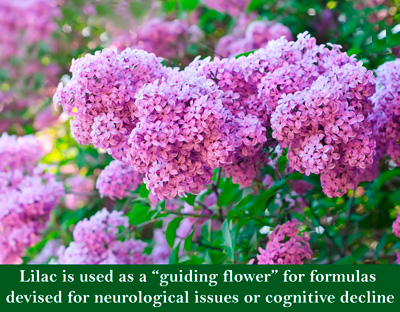
I could never support chemotherapy in good conscience, but for soul support for the animals receiving it, Arnica, Garlic, Penstemon, Olive, and Lady’s Mantle are used to restore their horribly profound etheric and literal depletion.
For appetite stimulation, and anemia, I use California Pitcher Plant.
For all of my cases with elevated liver enzymes, or in need of a detox due to a life of pharmaceutical inundation, I use Red Clover and Oregon Grape to assist with the destructive toxicity aspect.
About
 Shanti Zinzi believes a truly integrated education and commitment to life-long self-cultivation is required to be a practitioner of the healing arts. She is post-graduate educated in Somatic Psychology/behavior/counseling and Traditional Chinese Medicine. Her lifelong studies have been in Eastern, Western and internal arts. This spans from the creative arts to shamanism to ancient herbology. She believes the earth, creatures and cosmos are intimately connected and approaches her cases from a very subtle place that honors this sacred connection.
Shanti Zinzi believes a truly integrated education and commitment to life-long self-cultivation is required to be a practitioner of the healing arts. She is post-graduate educated in Somatic Psychology/behavior/counseling and Traditional Chinese Medicine. Her lifelong studies have been in Eastern, Western and internal arts. This spans from the creative arts to shamanism to ancient herbology. She believes the earth, creatures and cosmos are intimately connected and approaches her cases from a very subtle place that honors this sacred connection.
Shanti has worked for many wonderful veterinarians, interned at a holistic animal hospice, and strives to formulate a unique approach to the challenges that an allopathic and reductionistic paradigm fail to penetrate. She belonged to the International Association of Animal Behavioral Consultants and is an attendee of the American Holistic Veterinary Medical Association. She has an ongoing relationship in spiritual and medicinal studies from Buddhism to herbalism and dietary therapies.
http://shanti-zinzi.squarespace.com/
|
 Shanti Zinzi believes a truly integrated education and commitment to life-long self-cultivation is required to be a practitioner of the healing arts. She is post-graduate educated in Somatic Psychology/behavior/counseling and Traditional Chinese Medicine. Her lifelong studies have been in Eastern, Western and internal arts. This spans from the creative arts to shamanism to ancient herbology. She believes the earth, creatures and cosmos are intimately connected and approaches her cases from a very subtle place that honors this sacred connection.
Shanti Zinzi believes a truly integrated education and commitment to life-long self-cultivation is required to be a practitioner of the healing arts. She is post-graduate educated in Somatic Psychology/behavior/counseling and Traditional Chinese Medicine. Her lifelong studies have been in Eastern, Western and internal arts. This spans from the creative arts to shamanism to ancient herbology. She believes the earth, creatures and cosmos are intimately connected and approaches her cases from a very subtle place that honors this sacred connection.

![]() and then Add to Home Screen.
and then Add to Home Screen.


 Pericardium 8
Pericardium 8 




